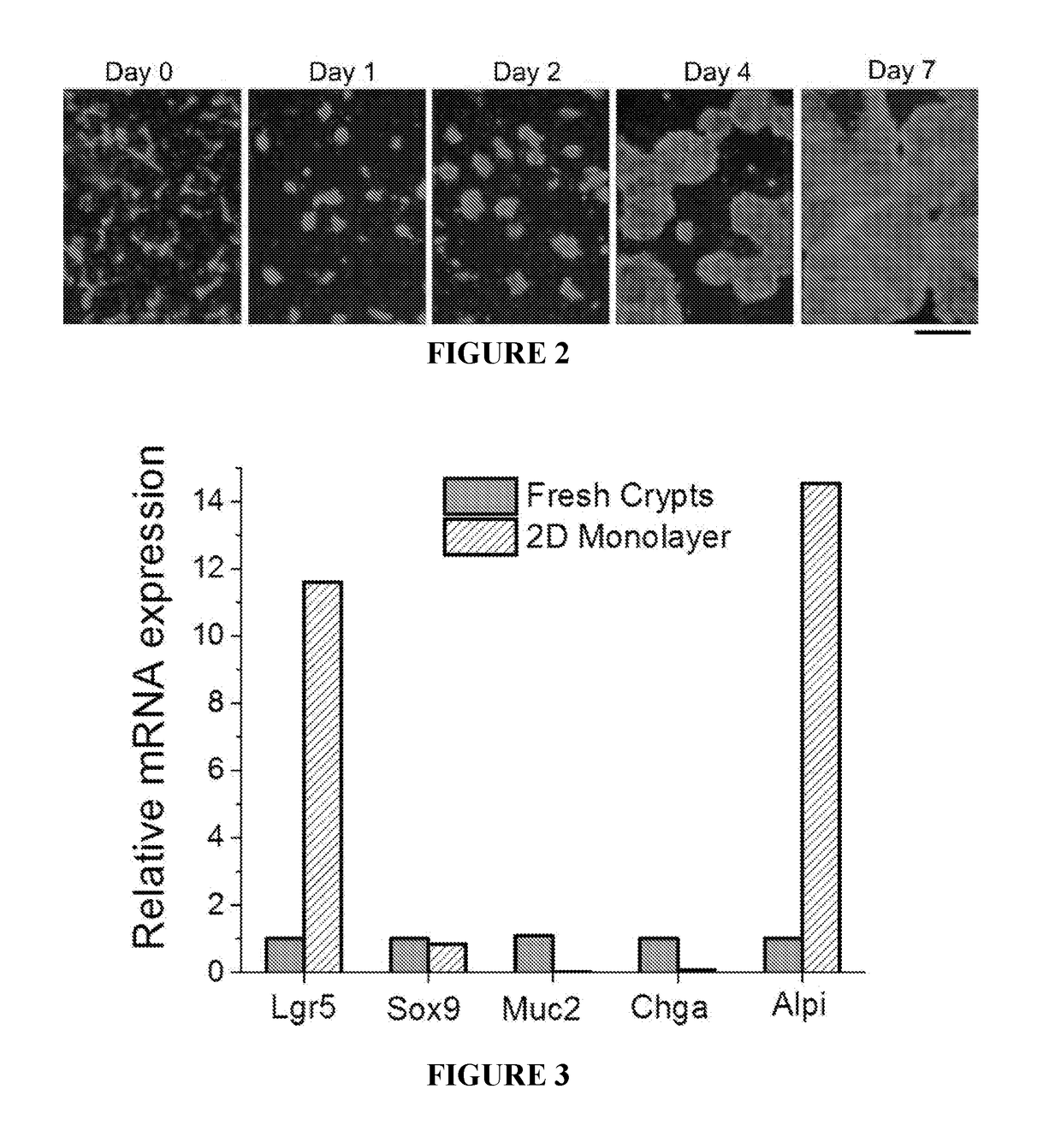Methods to generate gastrointestinal epithelial tissue constructs
a technology of gastrointestinal epithelium and constructs, which is applied in the field of methods to generate gastrointestinal epithelium constructs, can solve the problems of not improving crypt survival, not precisely mimicking the in vivo biochemical and biophysical microenvironments of crypts, and being extremely difficult to generate a long-term proliferative intestinal epithelium in vitro. achieve the effect of maintaining the viability of stem cells
- Summary
- Abstract
- Description
- Claims
- Application Information
AI Technical Summary
Benefits of technology
Problems solved by technology
Method used
Image
Examples
example 1
[0095]Demonstration of Long-Term Colonic Epithelial Monolayers on both 2d and 3d Scaffolds
[0096]As a demonstration of the current invention, two types of scaffolds, 2D and 3D scaffolds, were fabricated from collagen and demonstrated to support the long-term culture of cells obtained from primary colonic crypt tissue including the stem cells (FIG. 1). A 2D colonic epithelial monolayer was generated by culturing isolated crypts or stem cells on the surface of the planar, 2D scaffolds (FIG. 1A). Under this condition, the biochemical microenvironment was provided by the soluble growth factors (Wnt-3A, R-spondin, noggin and EGF), while the biophysical microenvironment was provided by the collagen scaffold which mimics the lamina propria in terms of permeability, stiffness, and ECM components. The monolayer contained proliferative stem cells. By changing the growth factors in the medium, the monolayer could be selectively differentiated at will into specialized cells, such as goblet cells...
example 2
[0116]The 2d Monolayer Possesses In Vivo-Like Proliferating Capability, Morphology and Function
[0117]In vivo, the intestinal epithelium is one of the most rapidly proliferating tissues in the mammalian body. Consistent with this, the in vitro 2D monolayer of colonic epithelial cells cultured on the collagen scaffold was highly proliferative. To demonstrate this proliferative capability, fragments of 2D monolayer were plated on the collagen scaffold in a Transwell insert (FIG. 7A, top panel). The perimeter of the insert is indicated by the white dotted line). By day 5, the cells generated a continuous 2D monolayer that occupied the entire surface of the insert with a surface area of 137 mm2 (FIG. 7B, bottom panel). This result demonstrates that the 2D monolayer culture technique can generate a large piece of colonic epithelial tissue in vitro, which is impossible to accomplish with the 3D organoid culture technique.
[0118]To investigate if the in vitro tissue possesses in vivo-like mo...
example 3
[0120]Scaffold Composition and Properties Determine the Morphology of Colonic Epithelium
[0121]We have shown that the colonic epithelial cells form a 2D monolayer of proliferative cells on the surface of a collagen gel. To explore other types of ECMs that can be used to build biomimetic scaffolds, we mixed Matrigel (protein concentration 8.7 mg / mL) and collagen (2 mg / mL) at different volumetric ratios and polymerized the resulting hydrogel at 37° C. for 1 h. The colonic epithelial cells were plated on the scaffolds and cultured under ENR-WB (see below for definition) for 5 days. The cells formed different morphologies (FIG. 8). The cells spread to form a 2D monolayer when the Matrigel composition was less than 25%, while the cells formed 3D spheroids when the Matrigel composition was higher than 50%. Our result show for the first time that 3D organoids can be formed on the top surface of Matrigel, without requiring the encapsulation of cells. One advantage is that all organoids are l...
PUM
 Login to View More
Login to View More Abstract
Description
Claims
Application Information
 Login to View More
Login to View More - R&D
- Intellectual Property
- Life Sciences
- Materials
- Tech Scout
- Unparalleled Data Quality
- Higher Quality Content
- 60% Fewer Hallucinations
Browse by: Latest US Patents, China's latest patents, Technical Efficacy Thesaurus, Application Domain, Technology Topic, Popular Technical Reports.
© 2025 PatSnap. All rights reserved.Legal|Privacy policy|Modern Slavery Act Transparency Statement|Sitemap|About US| Contact US: help@patsnap.com



